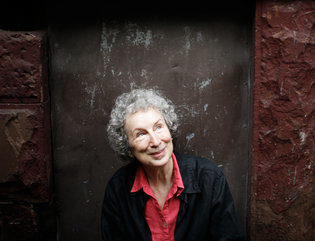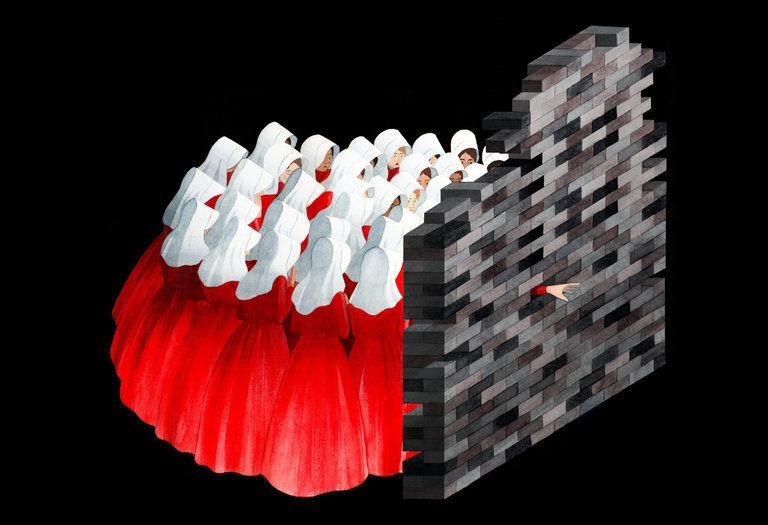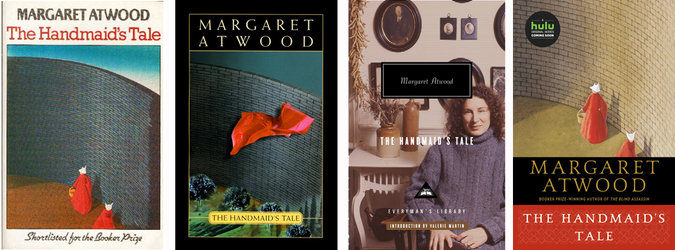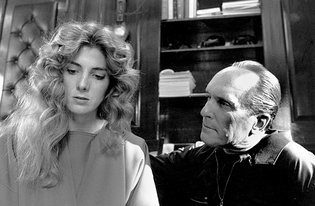The keyboard was German because I was living in West Berlin, which was still encircled by the Berlin Wall: The Soviet empire was still strongly in place, and was not to crumble for another five years. Every Sunday the East German Air Force made sonic booms to remind us of how close they were. During my visits to several countries behind the Iron Curtain — Czechoslovakia, East Germany — I experienced the wariness, the feeling of being spied on, the silences, the changes of subject, the oblique ways in which people might convey information, and these had an influence on what I was writing. So did the repurposed buildings. "This used to belong to . . . but then they disappeared." I heard such stories many times.
Having been born in 1939 and come to consciousness during World War II, I knew that established orders could vanish overnight. Change could also be as fast as lightning. "It can't happen here" could not be depended on: Anything could happen anywhere, given the circumstances.
By 1984, I'd been avoiding my novel for a year or two. It seemed to me a risky venture. I'd read extensively in science fiction, speculative fiction, utopias and dystopias ever since my high school years in the 1950s, but I'd never written such a book. Was I up to it? The form was strewn with pitfalls, among them a tendency to sermonize, a veering into allegory and a lack of plausibility. If I was to create an imaginary garden I wanted the toads in it to be real. One of my rules was that I would not put any events into the book that had not already happened in what James Joyce called the "nightmare" of history, nor any technology not already available. No imaginary gizmos, no imaginary laws, no imaginary atrocities. God is in the details, they say. So is the Devil.
Back in 1984, the main premise seemed — even to me — fairly outrageous. Would I be able to persuade readers that the United States had suffered a coup that had transformed an erstwhile liberal democracy into a literal-minded theocratic dictatorship? In the book, the Constitution and Congress are no longer: The Republic of Gilead is built on a foundation of the 17th-century Puritan roots that have always lain beneath the modern-day America we thought we knew.
The immediate location of the book is Cambridge, Mass., home of Harvard University, now a leading liberal educational institution but once a Puritan theological seminary. The Secret Service of Gilead is located in the Widener Library, where I had spent many hours in the stacks, researching my New England ancestors as well as the Salem witchcraft trials. Would some people be affronted by the use of the Harvard wall as a display area for the bodies of the executed? (They were.)
In the novel the population is shrinking due to a toxic environment, and the ability to have viable babies is at a premium. (In today's real world, studies are now showing a sharp fertility decline in Chinese men.) Under totalitarianisms — or indeed in any sharply hierarchical society — the ruling class monopolizes valuable things, so the elite of the regime arrange to have fertile females assigned to them as Handmaids. The biblical precedent is the story of Jacob and his two wives, Rachel and Leah, and their two handmaids. One man, four women, 12 sons — but the handmaids could not claim the sons. They belonged to the respective wives.
And so the tale unfolds.
When I first began The Handmaid's Tale it was called "Offred," the name of its central character. This name is composed of a man's first name, "Fred," and a prefix denoting "belonging to," so it is like "de" in French or "von" in German, or like the suffix "son" in English last names like Williamson. Within this name is concealed another possibility: "offered," denoting a religious offering or a victim offered for sacrifice.
Why do we never learn the real name of the central character, I have often been asked. Because, I reply, so many people throughout history have had their names changed, or have simply disappeared from view. Some have deduced that Offred's real name is June, since, of all the names whispered among the Handmaids in the gymnasium/dormitory, "June" is the only one that never appears again. That was not my original thought but it fits, so readers are welcome to it if they wish.
At some time during the writing, the novel's name changed to The Handmaid's Tale, partly in honor of Chaucer's Canterbury Tales, but partly also in reference to fairy tales and folk tales: The story told by the central character partakes — for later or remote listeners — of the unbelievable, the fantastic, as do the stories told by those who have survived earth-shattering events.
Over the years, The Handmaid's Tale has taken many forms. It has been translated into 40 or more languages. It was made into a film in 1990. It has been an opera, and it has also been a ballet. It is being turned into a graphic novel. And in April 2017 it will become an MGM/Hulu television series.
In this series I have a small cameo. The scene is the one in which the newly conscripted Handmaids are being brainwashed in a sort of Red Guard re-education facility known as the Red Center. They must learn to renounce their previous identities, to know their place and their duties, to understand that they have no real rights but will be protected up to a point if they conform, and to think so poorly of themselves that they will accept their assigned fate and not rebel or run away.
The Handmaids sit in a circle, with the Taser-equipped Aunts forcing them to join in what is now called (but was not, in 1984) the "slut-shaming" of one of their number, Jeanine, who is being made to recount how she was gang-raped as a teenager. Her fault, she led them on — that is the chant of the other Handmaids.
Although it was "only a television show" and these were actresses who would be giggling at coffee break, and I myself was "just pretending," I found this scene horribly upsetting. It was way too much like way too much history. Yes, women will gang up on other women. Yes, they will accuse others to keep themselves off the hook: We see that very publicly in the age of social media, which enables group swarmings. Yes, they will gladly take positions of power over other women, even — and, possibly, especially — in systems in which women as a whole have scant power: All power is relative, and in tough times any amount is seen as better than none. Some of the controlling Aunts are true believers, and think they are doing the Handmaids a favor: At least they haven't been sent to clean up toxic waste, and at least in this brave new world they won't get raped, not as such, not by strangers. Some of the Aunts are sadists. Some are opportunists. And they are adept at taking some of the stated aims of 1984 feminism — like the anti-porn campaign and greater safety from sexual assault — and turning them to their own advantage. As I say: real life.
Which brings me to three questions I am often asked.
First, is The Handmaid's Tale a "feminist" novel? If you mean an ideological tract in which all women are angels and/or so victimized they are incapable of moral choice, no. If you mean a novel in which women are human beings — with all the variety of character and behavior that implies — and are also interesting and important, and what happens to them is crucial to the theme, structure and plot of the book, then yes. In that sense, many books are "feminist."

The second question that comes up frequently: Is The Handmaid's Tale antireligion? Again, it depends what you may mean by that. True, a group of authoritarian men seize control and attempt to restore an extreme version of the patriarchy, in which women (like 19th-century American slaves) are forbidden to read. Further, they can't control money or have jobs outside the home, unlike some women in the Bible. The regime uses biblical symbols, as any authoritarian regime taking over America doubtless would: They wouldn't be Communists or Muslims.
The modesty costumes worn by the women of Gilead are derived from Western religious iconography — the Wives wear the blue of purity, from the Virgin Mary; the Handmaids wear red, from the blood of parturition, but also from Mary Magdalene. Also, red is easier to see if you happen to be fleeing. The wives of men lower in the social scale are called Econowives, and wear stripes. I must confess that the face-hiding bonnets came not only from mid-Victorian costume and from nuns, but from the Old Dutch Cleanser package of the 1940s, which showed a woman with her face hidden, and which frightened me as a child. Many totalitarianisms have used clothing, both forbidden and enforced, to identify and control people — think of yellow stars and Roman purple — and many have ruled behind a religious front. It makes the creation of heretics that much easier.
In the book, the dominant "religion" is moving to seize doctrinal control, and religious denominations familiar to us are being annihilated. Just as the Bolsheviks destroyed the Mensheviks in order to eliminate political competition and Red Guard factions fought to the death against one another, the Catholics and the Baptists are being targeted and eliminated. The Quakers have gone underground, and are running an escape route to Canada, as — I suspect — they would. Offred herself has a private version of the Lord's Prayer and refuses to believe that this regime has been mandated by a just and merciful God. In the real world today, some religious groups are leading movements for the protection of vulnerable groups, including women.
So the book is not "antireligion." It is against the use of religion as a front for tyranny; which is a different thing altogether.
Is The Handmaid's Tale a prediction? That is the third question I'm asked — increasingly, as forces within American society seize power and enact decrees that embody what they were saying they wanted to do, even back in 1984, when I was writing the novel. No, it isn't a prediction, because predicting the future isn't really possible: There are too many variables and unforeseen possibilities. Let's say it's an antiprediction: If this future can be described in detail, maybe it won't happen. But such wishful thinking cannot be depended on either.
So many different strands fed into The Handmaid's Tale — group executions, sumptuary laws, book burnings, the Lebensborn program of the SS and the child-stealing of the Argentine generals, the history of slavery, the history of American polygamy . . . the list is long.
But there's a literary form I haven't mentioned yet: the literature of witness. Offred records her story as best she can; then she hides it, trusting that it may be discovered later, by someone who is free to understand it and share it. This is an act of hope: Every recorded story implies a future reader. Robinson Crusoe keeps a journal. So did Samuel Pepys, in which he chronicled the Great Fire of London. So did many who lived during the Black Death, although their accounts often stop abruptly. So did Roméo Daillaire, who chronicled both the Rwandan genocide and the world's indifference to it. So did Anne Frank, hidden in her secret annex.
There are two reading audiences for Offred's account: the one at the end of the book, at an academic conference in the future, who are free to read but who are not always as empathetic as one might wish; and the individual reader of the book at any given time. That is the "real" reader, the Dear Reader for whom every writer writes. And many Dear Readers will become writers in their turn. That is how we writers all started: by reading. We heard the voice of a book speaking to us.
In the wake of the recent American election, fears and anxieties proliferate. Basic civil liberties are seen as endangered, along with many of the rights for women won over the past decades, and indeed the past centuries. In this divisive climate, in which hate for many groups seems on the rise and scorn for democratic institutions is being expressed by extremists of all stripes, it is a certainty that someone, somewhere — many, I would guess — are writing down what is happening as they themselves are experiencing it. Or they will remember, and record later, if they can.
Will their messages be suppressed and hidden? Will they be found, centuries later, in an old house, behind a wall?
Let us hope it doesn't come to that. I trust it will not.
About the author
Margaret Atwood is the author of more than 20 works of fiction. "The Handmaid's Tale" will be released by Hulu as a 10-part television series in April, and this essay is the introduction to the new Anchor paperback edition to be published on April 11.






[Link]